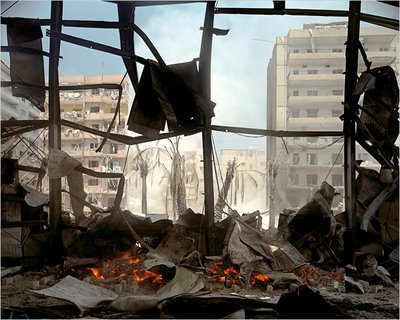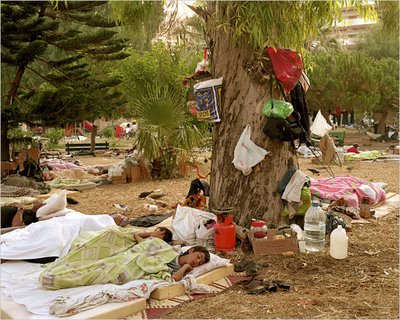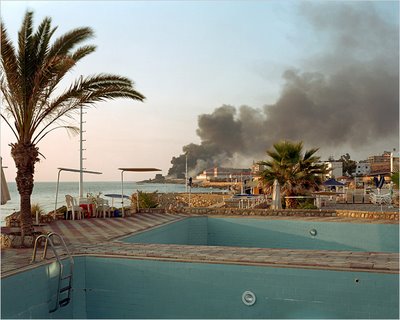 MILIT_URB(S)So Long, Cheyenne Mountain
MILIT_URB(S)So Long, Cheyenne Mountain: Well, the folks at the Target Store in Colorado Springs can breath a sigh of relief: NORAD is moving up the road to Peterson Air Force Base and putting Cheyenne Mountain on standby.
C'mon kids, let's go to Army World!: The Army is considering a proposal to allow a private developer to build a military-themed park that would include Cobra Gunship rides and bars including a "1st Division Lounge."
Wanted: personal reflections on living in a climate of war: OPENSOURCE ART: In War/At War: The Practice of Everyday. In War/At War: The Practice of Everyday is an exhibition and series of events that investigates variations on everyday practices, projects, and tactics explored by individuals whom cope, adapt and adjust to War and the climate it produces.
Left to Their Own Devices: In dubious battle: The military's love affair with technology, from video game to secret weapons.
The War on Terror: Shell-shocked troops are coming back from Iraq with snakes in their heads. A new virtual reality treatment offers hope for vets.
Marines Use MySpace to Recruit: So far, over 12,000 web surfers have signed on as friends of the Corps in response to the latest military recruiting tactic.
Memorial or BillBoard?: James Ingo Freed's Memorial to the United States Air Force Memorial--an inverted triparted triumphal arch rises into the air in Washington D.C.
Army & Air Force Exchange Service Turns 111: Today, AAFES relies on more than 3,100 facilities in 49 states and more than 35 countries to extend the exchange benefit to Soldiers and Airmen serving in almost every corner of the globe. In fact, more than 450 AAFES associates are deployed to Operations Enduring and Iraqi Freedom, actively delivering a slice of Americana to troops through 52 retail stores, 69 phone centers and more than 170 fast food restaurants scattered throughout the region. Just like the merchants who supplied provisions to America’s troops in the late 1800s, these associates live and work alongside the troops they serve.
Private Spaceport Plan up for Air: A spacecraft taking off from a private West Texas spaceport being bankrolled and developed by Amazon.com founder Jeff Bezos would take off vertically, but unlike NASA's space shuttle would also land vertically, according to an environmental study that offers a glimpse into the secretive plans.
From Nowhere to Out There: From the passenger seat of Bill Gutman’s truck, Spaceport America looks more John Ford than Jetsons. No gleaming buildings, no space-age machinery, just a few strips of concrete, two portable office buildings and 27 square miles of scrubby cactus.
Deadly nuke rods piling up in state, Burial site project in Nevada in limbo: Thousands of tons of deadly radioactive rods of spent nuclear fuel and waste have accumulated at three California nuclear power plants because the federal government has failed to open a permanent nuclear burial site in Nevada that was supposed to be ready eight years ago.
Belt-tightening at bases in US starts to strain: An Army long strained by the manpower demands of Iraq and Afghanistan is increasingly facing a new obstacle at home: The service is fast running out of money.
An energy microgrid for the Army: Researchers from Sandia National Laboratories (SNL) are working with the U.S. Army on an energy surety model which soon will be tested by military bases. Instead on relying on today's grid electricity system, this microgrid system will use small power generation units close to where people live and work.
Sim Air Control: One of the neato tools at JAGOG's disposal is a new 360-degree dome simulator (see pic) that drops student forward air controllers into an Iraq-esque scenario featuring tough moving targets and itchy Air Force jet jockeys looping overhead.
Seal Silo: The Marine Mammal Center (MMC) in Sausalito, California, treats elephant seals and is now receiving a much-needed, multi-million dollar architectural upgrade – and the new design fascinatingly incorporates a derelict "pair of Nike missile silos."
China's Area 51 on Google Earth?: Last month, while scrutinizing landscapes in China, German Googler "KenGrok" discovered what appeared to be a terrain model on a Chinese military base. And it was not just any terrain.
Pak Bomb Factory: David Albright and Paul Brannan of the Institute for Science and International Security (ISIS) released commercially available satellite images of a new Pakistani plutonium production reactor under construction.
Huangyangtan: or, Tactical geoannexation, Part II: Landscape architects as agents of psychological warfare. Instead of midnight sonic booms and recursive Spice Girls medleys, your enemy watches televisually on Google Earth as you rape and pillage their own backyards, knowing that the real thing, perfectly choreographed and endlessly practiced, may come at anytime.
Masking the Fortress Moat: The Bollard Era is upon us, soon anything and everything will serve as some sort of security barrier, just some less obvious than others. But can a fortress - even an invisible one - allow for a strong and open civic experience?
 URBAN CARCERALALITYGiant Robot Imprisons Parked Cars
URBAN CARCERALALITYGiant Robot Imprisons Parked Cars: The robot that parks cars at the Garden Street Garage in Hoboken, New Jersey, trapped hundreds of its wards last week for several days. But it wasn't the technology car owners had to curse, it was the terms of a software license.
School Officials Promote Fast Track to Incarceration: Youth- and civil-rights advocates are speaking out against the rising presence of cops on campuses and administration complicity in what critics call a school-to-prison pipeline.
Prisoners of Katrina: In the aftermath of Hurricane Katrina, while thousands fled New Orleans, the city's prisoners were trapped. Fresh eye-witness accounts reveal what really happened to those left behind, and how crucial forensic evidence was simply washed away.
Guantanamo inmates used al Qaeda manual: The first wave of detainees at the military prison at Guantanamo Bay, Cuba, created their own internal organizational structure to maintain morale, resist interrogation and recruit members, adhering to instructions in a 10-year-old al Qaeda training manual, according to a classified report by CIA analysts.
Detention facility pacts irk official: The Willacy County attorney is speaking out against his county's new contract for a massive detention center because he said it involves companies still under a cloud from the 2004 bribery convictions of three elected officials.
Club Gulag: tourists are offered prison camp experience: The Mayor of what used to be one of the most infamous outposts of Josef Stalin's Gulag wants to charge masochistic foreign tourists £80 a day to "holiday" in an elaborate mock-up of a Soviet prison camp.
 ENDLESS, in the MIDEAST Targeting Territory in Lebanon
ENDLESS, in the MIDEAST Targeting Territory in Lebanon: "Our media is giving the impression that Israel is only fighting along the border in a defensive manner. The map exposes this lie of ommission -- this is an all out attempt to destroy the country of Lebanon."
In Iraq, a Failure to Deliver the Spoils: In the United States, the question of the effectiveness of the roughly $45 billion in rebuilding generally boils down to a statistical debate, with proponents saying that thousands of projects have been completed, and critics pointing to thousands that are incomplete or have not even started.
Iraq's Reconstruction a Boondoggle by Design: Iraq's reconstruction has been a crude taxpayer rip-off -- and while $30 billion has been spent, only 30 percent of Iraqis are even aware of the rebuilding effort.
Audit Finds U.S. Hid Actual Cost of Iraq Projects: The State Department agency in charge of $1.4 billion in reconstruction money in Iraq used an accounting shell game to hide ballooning cost overruns on its projects there and knowingly withheld information on schedule delays from Congress, a federal audit released late Friday has found.
A potential US Stalingrad in Iraq?: Hostilities between Iran and the United States or a change in attitude toward US forces on the part of the Baghdad government could quickly turn the supply roads into a "shooting gallery" 400 to 800 miles long.
In Iraq, a failed housing market: Not squatters, but on their way, perhaps. This story on the housing crisis in Iraq from the Institute for War and Peace Reporting shows that market forces are conspiring against ordinary Iraqis in Sulaimaniyah.
Iraq Civilian Toll Spikes to Almost 6,000Israeli/Lebanese coffin counter: A simple and extremely sad visualization of the proportionality of deaths in the conflict between Isreal & Lebanon.
Israeli Bombs Shatter Beirut Renaissance: Beirut’s architectural renaissance, featuring work by architects including Gustafson Porter and Zaha Hadid, was falling apart this week as the Israeli bombings continued.
Walking in fear in Lebanon's no-drive zone: Moving anywhere in Lebanon south of the Litani River today is an eerie and unnerving experience.
From City to "Stronghold"...to Graveyard: Modern warfare thrives largely on the basis of euphemisms which render the otherwise abhorrent acceptable: we do not speak of murdered civilians, but of "collateral damage;" not of destroyed societies but of "degraded capability."
Why Hezbollah is proving so tough on the battlefield: A look at the geurilla infrastructure of Hizbollah, and why they have been such an effective resistence.
Israel plans anti-tunnel measures in Gaza: Israel plans to raze homes and other structures just inside the Gaza Strip to stop Palestinian militants from using them as cover to build tunnels for attacks and smuggling.
Hezbollah Leads Work to Rebuild, Gaining Stature: "...in addition to its hard-won reputation as the only Arab force that fought Israel to a standstill — Hezbollah is already dominating the efforts to rebuild with a torrent of money from oil-rich Iran.
Rebuilding Lebanon's shattered economy: With a truce between Israel and Hezbollah raising hopes of peace in Lebanon, much of the focus is moving towards the task at hand: how to rebuild the country and how to pay for it.

SECURITY, SURVEILLANCE, CHECKPOINTSAirports battle new security threats: Air travel has been transformed since al-Qaeda hijackers seized aeroplanes to use as weapons on 11 September 2001. But nothing has been as draconian as the steps taken in the UK following the discovery of a suspected plot to blow up several planes in mid-air.
Video cameras on the lookout for terrorists: Researchers at General Electric Co.'s sprawling research center, are creating new "smart video surveillance" systems that can detect explosives by recognizing the electromagnetic waves given off by objects, even under clothing.
ThreatViewer enables you to see in all directions at once: As thousands gathered for Major League Baseball's All-Star game in Pittsburgh on July 11, a new technology known as ThreatViewer was being deployed for the first time that enables security personnel to do just that.
Meth Gun for drug detection: The "meth gun" looks similar to a radar gun but it's made to help police find trace amounts of dope. According to CDEX Inc., the $10,000 device is the first portable, handheld system that uses ultraviolet light to scan surfaces (most likely at close range).
The world's most secure front doorProtecting Subway Cars From Bombs: Toronto is modifying its subway cars to improve safety in this age of terrorist bombings, while one expert says the change will only create an illusion of safety.
3-D Imaging Goes Ballistic: New ballistics-imaging technology, developed by a Rockville, Maryland, engineering firm with funding from the Justice Department, lets forensic scientists capture a fired bullet's distinctive markings in 3-D for the first time.
Sizing Up the People Who Tell Us to Take Our Shoes Off: With the disclosure last week of a plot to bomb airplanes flying over the Atlantic with liquid or gel explosives, those workers are again a focus of attention as a vital line of defense against terrorism. But it is a seriously flawed line, some security consultants and government officials say. The federal workers under the Department of Homeland Security who replaced the screeners hired by private contractors remain a weak link in aviation safety.
























































